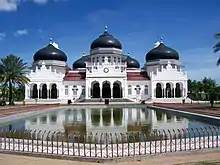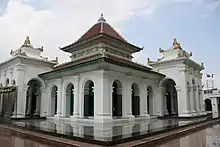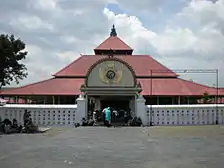Great Mosque of Banten
Great Mosque of Banten (Indonesian Masjid Agung Banten) is a historic mosque in Old Banten, 10 km north of Serang, Indonesia. The 16th-century mosque was one of the few surviving remnants of what used to be the port city of Banten, the most prosperous trading center in the Indonesian archipelago after the fall of Demak Sultanate in mid-16th century.[1]
| Great Mosque of Banten | |
|---|---|
ᮙᮞ᮪ᮏᮤᮓ᮪ ᮃᮍᮥᮀ ᮘᮔ᮪ᮒᮨᮔ᮪ Masjid Agung Banten | |
 The Great Mosque of Banten. | |
| Religion | |
| Affiliation | Islam |
| Province | Banten |
| Status | Active |
| Location | |
| Location | Old Banten, Indonesia |
| Geographic coordinates | 6.035999°S 106.154017°E |
| Architecture | |
| Type | Mosque |
| Style | Javanese vernacular |
| Completed | 1566 |
| Specifications | |
| Direction of façade | East |
| Minaret(s) | 1 |
| Minaret height | 24 metres (79 ft) |
History

The Great Mosque of Banten shows eclectic design, a proof of the international influence in Banten at the time of its construction. The mosque was constructed in Javanese style during the reign of Sultan Maulana Yusuf, the third Sultan of Banten Sultanate, in Dzulhijjah AH 966 (1566 CE).[2]
A Javanese-styled pawestren (side hall, used for female's praying hall) was added during the reign of Maulana Muhammad (1580-1586). The southern serambi (porch) of the mosque was converted into a tomb containing about 15 graves.[3]
In 1632, a 24-meter minaret was added to the mosque complex.[2] The minaret was designed by a Chineseman Cek-ban-cut.[4] Around similar period the Dutch-styled tiyamah was added to the mosque following the design of Hendrik Lucaasz Cardeel, a Dutchman who was converted to Islam.[3]
Architecture
In a typical architecture of Javanese mosque, the Great Mosque of Banten consists of the main prayer hall and a covered veranda (serambi). The serambi is a semi-attached porch-like structure which provides entrance to the main prayer hall. The main prayer features a five-tiered roof supported by four main posts (saka guru). The three uppermost tier is arranged rather uniquely, appearing more like a Chinese pagoda than the regular multi-tiered roof of Javanese architecture. There is a dispute over the original number of the tiers of the main prayer hall; sketches of the city in 1596, 1624, 1661 and 1726 shows the number of the tier as not more than three tiers, while Valentijn (1858) mentioned the number of the tier is five as it is today.[3] The covered verandas were added to the main mosque building, built in the north and south side of the mosque.
Being a port town, the Great Mosque of Banten features eclectic elements, which appear in the overall enclosed space of the mosque, the minaret, and the tiyamah building. The minaret is a popular icon of the Great Mosque of Banten. It is a 24 meter high, brick minaret, with a 10 meter in diameter octagonal base.[3] The shape is reminiscent of a lighthouse. The architecture features a mix of Indian Mughal pattern and ancient candi decoration.[5]
Beside the mosque is a two-floored building built in the 17th-century Dutch style. This building, known as the tiyamah, was erected at the order of Sultan Haji of Banten and designed by a Dutchman, Hendrik Lucaasz Cardeel. Cardeel converted to Islam, became a member of the Banten court with the title Pangeran Wiraguna, and designed this building which now stands on the southwest side of the Great Mosque. It is still used as a center for Islamic study.[6]
There are several tombs in the mosque complex, such as the tomb of Sultan Maulana Hasanuddin and his wife, Sultan Ageng Tirtayasa and Sultan Abu Nasir Abdul Qohhar.
See also
| Wikimedia Commons has media related to Great Mosque of Banten. |
References
- Jo Santoso 1998, p. 102.
- Zein 1999, p. 164.
- Branti 2015.
- the Jakarta Post 1999.
- Miksic 1998, p. 86.
- Jo Santoso 1998, p. 103.
Works cited
- "Banten abounds in arceological treasures". the Jakarta Post - Life. Jakarta. July 10, 1999. Archived from the original on February 4, 2013. Retrieved October 5, 2016.
- Branti (July 15, 2015). "Keistimewaan Masjid Agung Banten" [The uniqueness of Banten Great Mosque]. Kebudayaan Indonesia (in Indonesian). Direktorat Jenderal Kebudayaan Republik Indonesia. Archived from the original on October 5, 2016. Retrieved October 5, 2016.
- Jo Santoso (1998). Gunawan Tjahjono (ed.). Cities of the Pesisir. Indonesian Heritage. 9. Singapore: Archipelago Press. ISBN 9813018585.
- Miksic, John (1998). Gunawan Tjahjono (ed.). Architecture of the Early Islamic Period. Indonesian Heritage. 9. Singapore: Archipelago Press. ISBN 9813018585.
- Zein, Abdul Baqir (1999). Masjid-masjid bersejarah di Indonesia [Historic mosques in Indonesia] (in Indonesian). Jakarta: Gema Insani. ISBN 9789795615675.










